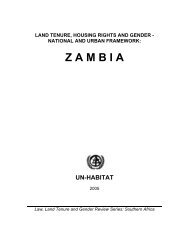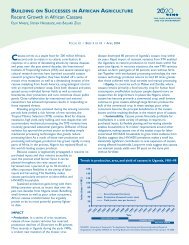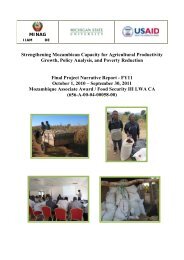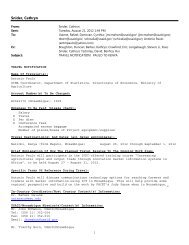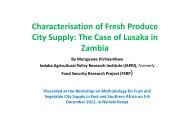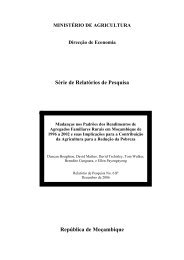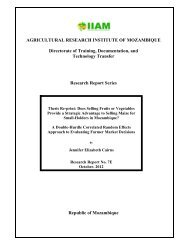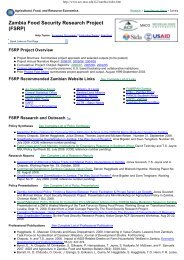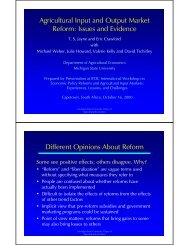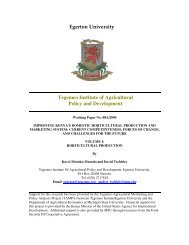Fertilizer Markets and Agricultural Production Incentives - Tegemeo ...
Fertilizer Markets and Agricultural Production Incentives - Tegemeo ...
Fertilizer Markets and Agricultural Production Incentives - Tegemeo ...
You also want an ePaper? Increase the reach of your titles
YUMPU automatically turns print PDFs into web optimized ePapers that Google loves.
1. INTRODUCTION<br />
Agriculture is the major economic sector in Kenya, employing over 70% of the population <strong>and</strong><br />
contributing 24.6% to GDP (Economic Review, 1999). Therefore, economic development<br />
hinges on an improvement in agricultural productivity which, in turn, hinges on the use of<br />
productivity-enhancing inputs such as fertilizer.<br />
As was the case in many African countries, in the late 80’s the Government of Kenya embarked<br />
upon a process to reform its agricultural sector, including the fertilizer subsector. However,<br />
unlike most other African countries, fertilizer market reform in Kenya has entailed not just the<br />
legalization of private trade, but also the virtual exit of government from continued involvement<br />
in distributing fertilizer. In other African countries, concerns with the ability of the private<br />
sector to meet the needs of smallholder farmers, especially with regard to credit <strong>and</strong> service<br />
provision to farmers in remote areas, has motivated governments to continue distributing<br />
fertilizer during the liberalization period, often at subsidized prices. Some studies have<br />
concluded that government distribution programs have often hampered commercial trading<br />
incentives <strong>and</strong> hence impeded the private sectors’ response to liberalization (IFDC 2001;<br />
Govereh et al 2001; Stepanek et al 2001). By contrast, in 1993, the Government of Kenya<br />
withdrew completely from fertilizer distribution <strong>and</strong> since then, it has relied on the private sector<br />
<strong>and</strong> cooperatives to meet the fertilizer needs of farmers. By contrast, 95% of the fertilizer<br />
consumed in Kenya is imported <strong>and</strong> distributed by the private sector. 1 Because of this, the<br />
Kenyan experience provides an interesting test of how fertilizer markets have evolved (for a<br />
given level of institutional <strong>and</strong> infrastructural development) <strong>and</strong> whether they effectively serve<br />
the needs of smallholder farmers.<br />
Figure 1 shows the current organization of the fertilizer market. There are two types of private<br />
sector groups involved in the market. The first group consists of importers, wholesalers <strong>and</strong><br />
retailers who sell to farmers <strong>and</strong> to non-governmental organizations. The second group consists<br />
of smallholder cash-cropping firms involved in interlocked input-output market arrangements,<br />
<strong>and</strong> large estates, some of whom import their own fertilizer directly <strong>and</strong> some of whom purchase<br />
fertilizer directly from private importers. This paper focuses on the segment of the private sector<br />
that is comprised of importers, wholesalers <strong>and</strong> retailers. It is hereafter referred to as the private<br />
sector.<br />
Government <strong>and</strong> donors anticipated that the fertilizer market reforms would initiate major<br />
investment by private firms in fertilizer distribution <strong>and</strong> marketing that would increase financial<br />
<strong>and</strong> physical access to fertilizers, particularly by smallholders who had been neglected under the<br />
1 The remaining 5% is donor-sourced by the Ministry of Agriculture-KRII program (MOA-KRII) which<br />
imports fertilizers that the private sector does not import, <strong>and</strong> sells it to private traders via an open tendering system.<br />
Instead of the government receiving aid monies, it receives the goods (fertilizers, pesticides, <strong>and</strong> agricultural <strong>and</strong><br />
industrial machinery from Japanese companies) which it sells internally to the private sector <strong>and</strong> uses the proceeds<br />
to finance donor-approved development projects in any economic sector.<br />
1




